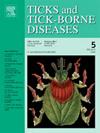Environmental and host factors underlying tick-borne virus infection in wild animals: Investigation of the emerging Yezo virus in Hokkaido, Japan
IF 3.4
2区 医学
Q2 INFECTIOUS DISEASES
引用次数: 0
Abstract
Yezo virus (YEZV) is an emerging tick-borne virus that causes acute febrile illness. It has been continuously reported in patients and ticks in Japan and China since its first identification in Hokkaido, Japan. While serological tests have demonstrated that YEZV infections are prevalent in wild animals, such as raccoons (Procyon lotor), the determinants of infection in wild animals remain largely unknown. We examined the prevalence of YEZV in invasive raccoons, native tanukis (raccoon dogs, Nyctereutes procyonoides albus), and ticks in six study areas in Hokkaido between 2018 and 2023 to identify ecological factors underlying YEZV infection in wild animals. YEZV RNA fragments were detected in 0.22% of the 1,857 questing ticks. Anti-YEZV antibodies were detected in 32 of the 514 (6.2%) raccoon serum samples and in 5 of the 40 (12.5%) tanuki serum samples. Notably, the seroprevalence in raccoons varied significantly in one of the study areas over the years, that is, 0.0%, 60.0%, and 28.6% in 2021, 2022, and 2023, respectively, implying the temporary emergence of YEZV microfoci. By analyzing the tick load and YEZV seropositivity in raccoons in a field-based setting, we found a positive correlation between adult Ixodes ovatus load and YEZV-antibody positivity, highlighting the importance of I. ovatus in YEZV infection in wild animals. We also explored the environmental and host factors influencing YEZV seropositivity in raccoons and tanukis and found that landscape factors, such as the size of forest area around the trap site, were crucial for YEZV seropositivity in these animals. The significant variables for YEZV seropositivity in raccoons were partially different from those affecting tick infestation intensity in raccoons. The present results extend our understanding of tick-borne virus circulation in the field, emphasizing the unique ecology of the emerging YEZV.
野生动物中蜱传病毒感染的环境和宿主因素:日本北海道新发Yezo病毒的调查
耶佐病毒(YEZV)是一种新出现的蜱传病毒,可引起急性发热性疾病。自日本北海道首次发现该病毒以来,日本和中国的患者和蜱虫中不断有报告。虽然血清学试验表明,YEZV感染在野生动物(如浣熊)中普遍存在,但野生动物感染的决定因素在很大程度上仍然未知。2018年至2023年,我们在北海道6个研究区检测了入侵浣熊、本地狸猫(貉、原yonoides albus夜蛾)和蜱的YEZV流行情况,以确定野生动物YEZV感染的生态因素。1857只蜱中有0.22%检出YEZV RNA片段。514份貉血清和40份狸猫血清中分别有32份(6.2%)和5份(12.5%)检测到抗yezv抗体。值得注意的是,其中一个研究区域的貉血清阳性率在不同年份变化明显,分别在2021年、2022年和2023年为0.0%、60.0%和28.6%,表明YEZV微疫暂时出现。通过对野外环境中貉的蜱虫载量和YEZV抗体阳性情况的分析,我们发现卵形伊蚊成虫载量与YEZV抗体阳性呈正相关,说明卵形伊蚊在野生动物YEZV感染中的重要作用。我们还探讨了环境和宿主因素对浣熊和狸猫YEZV血清阳性的影响,发现景观因素,如诱捕地点周围森林面积的大小,对这些动物的YEZV血清阳性至关重要。影响貉YEZV血清阳性的显著变量与影响貉蜱侵害强度的显著变量存在部分差异。目前的结果扩展了我们对蜱传病毒在野外传播的理解,强调了新兴的YEZV的独特生态。
本文章由计算机程序翻译,如有差异,请以英文原文为准。
求助全文
约1分钟内获得全文
求助全文
来源期刊

Ticks and Tick-borne Diseases
INFECTIOUS DISEASES-MICROBIOLOGY
CiteScore
6.90
自引率
12.50%
发文量
185
审稿时长
6-12 weeks
期刊介绍:
Ticks and Tick-borne Diseases is an international, peer-reviewed scientific journal. It publishes original research papers, short communications, state-of-the-art mini-reviews, letters to the editor, clinical-case studies, announcements of pertinent international meetings, and editorials.
The journal covers a broad spectrum and brings together various disciplines, for example, zoology, microbiology, molecular biology, genetics, mathematical modelling, veterinary and human medicine. Multidisciplinary approaches and the use of conventional and novel methods/methodologies (in the field and in the laboratory) are crucial for deeper understanding of the natural processes and human behaviour/activities that result in human or animal diseases and in economic effects of ticks and tick-borne pathogens. Such understanding is essential for management of tick populations and tick-borne diseases in an effective and environmentally acceptable manner.
 求助内容:
求助内容: 应助结果提醒方式:
应助结果提醒方式:


